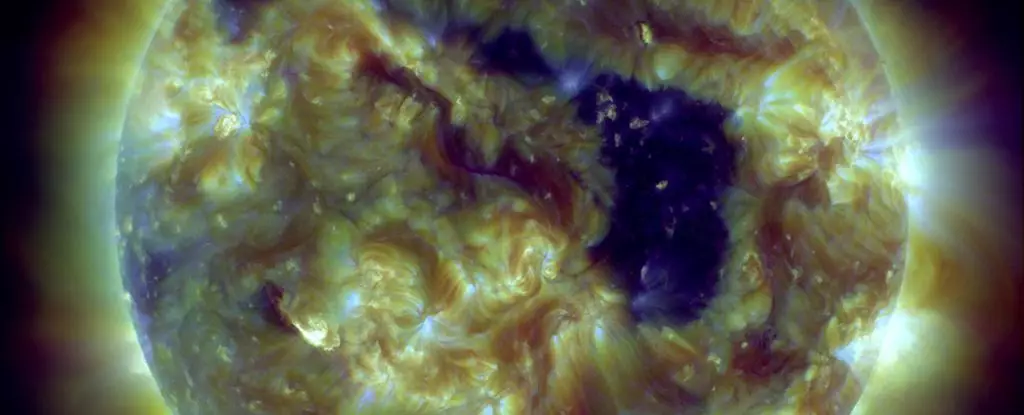The Parker Solar Probe, a solar probe that made a dangerous plunge into the Sun’s corona, has now traced the wind that blows from the Sun’s surface back to its source. The probe made a record-breaking approach of 8.5 million kilometers (5.3 million miles) to the Sun in November 2021, which allowed the detection of the fine structure of the solar wind. The solar wind is responsible for carrying tons of charged particles from the Sun into the Solar System through a hole in the Sun’s corona. The Parker Solar Probe’s readings have given scientists the closest look yet at how the fast solar wind is generated, suggesting that a specific type of magnetic reconnection is what drives this powerful force of nature.
The readings have been analyzed by a team of physicists led by Stuart Bale of the University of California, Berkeley, and James Drake of the University of Maryland, College Park. The research is significant as this wind carries important information from the Sun to Earth, and understanding the mechanism behind the Sun’s wind is essential for practical reasons on Earth. The research will help in understanding how the Sun releases energy and drives geomagnetic storms, which are a threat to our communication networks.
Coronal Holes
The Sun is a magnetic mess, and a lot of changes in its magnetic field manifest as phenomena in the corona. Coronal holes, which are normal solar phenomena, occur when the magnetic field lines open and expand outward, rather than forming closed loops. The result is a patch of cooler, less dense plasma in the corona that becomes much darker in extreme ultraviolet wavelengths. From these regions emerge powerful solar winds that blow charged particles far into the Solar System. These winds can interact with our upper atmosphere to generate spectacular auroras and interfere with satellite operations and radio communications.
During the Sun’s 11-year activity cycle, coronal holes can appear at any time. When the Sun is at the point of minimal activity, or solar minimum, they tend to hang around the poles. But at solar maximum, when the Sun’s magnetic poles swap places, and as activity declines afterward, coronal holes become more numerous and appear pretty at all latitudes, and more fast solar winds are pointed in our direction.
The Findings
During its close approach to the Sun in November 2021, the Parker Solar Probe was fortuitously situated so that it could collect the closest observations of one of these regions obtained yet. The resulting data showed that the coronal hole is similar to a showerhead, with roughly evenly spaced jets emerging from places where magnetic field lines “funnel” into and out of the surface of the Sun.
“The photosphere is covered by convection cells, like in a boiling pot of water, and the larger scale convection flow is called supergranulation,” Bale explains. “Where these supergranulation cells meet and go downward, they drag the magnetic field in their path into this downward kind of funnel. The magnetic field becomes very intensified there because it’s just jammed.”
The researchers found that in magnetically complicated spots on the Sun, things can get a bit wild, with magnetic field lines tangling, snapping and reconnecting. This magnetic reconnection is a violent process that releases a lot of energy. One of the possible ways the solar wind is generated is when open and closed magnetic fields reconnect in a process called interchange reconnection. Another possible explanation is particle acceleration by electromagnetic waves in coronal holes called Alfvén waves, generated by the interaction between convective flows and magnetic fields.
The Parker Solar Probe clocked particles traveling at incredibly high speeds, between 10 and 100 times the speed of the average solar wind. This, they say, is more consistent with interchange reconnection than Alfvén wave acceleration and consistent with other recent findings based on Parker data.
“The big conclusion is that it’s magnetic reconnection within these funnel structures that’s providing the energy source of the fast solar wind,” Bale says. “It doesn’t just come from everywhere in a coronal hole, it’s substructured within coronal holes to these supergranulation cells. It comes from these little bundles of magnetic energy that are associated with the convection flows. Our results, we think, are strong evidence that it’s reconnection that’s doing that.”
The new findings from the Parker Solar Probe have traced the source of solar wind back to its origin, providing a better understanding of the mechanism behind the Sun’s wind. The research shows that it’s magnetic reconnection within funnel structures that’s providing the energy source of the fast solar wind. These findings will help in understanding how the Sun releases energy and drives geomagnetic storms, which are a threat to our communication networks.



Leave a Reply